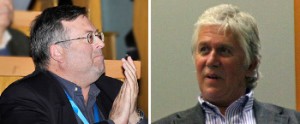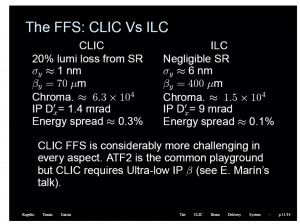On 11 January 2010 the ILC Steering Committee and the Compact Linear Collider study (CLIC) Collaboration Board created a working group to exploit synergies and discuss general issues involving the linear collider. That group has met regularly throughout the last year and submitted an interim report to their respective oversight groups this month. So far, they have concentrated on the first two elements of their charge: identifying synergies to enable the design concepts of the ILC and CLIC to be prepared efficiently and discussing plans for ILC and CLIC efforts to identify common issues regarding siting, technical issues and project planning. Their interim report summarises discussions and draws some preliminary conclusions.
The general issues working group consists of Eckhard Elsen (DESY), Mike Harrison (BNL, co-chair), Philippe Lebrun (CERN, co-chair), Ken Peach (Oxford), Daniel Schulte (CERN) and Kaoru Yokoya (KEK). So far, the group has concentrated on discussions and recommendations for the next few years, because of the great uncertainties on the longer term. For example, how will the LHC physics results affect the desired initial energy? How will reduced CLIC funding and post-2012 ILC organisational issues affect the future programmes?
Collaborative work is proceeding through working groups on beam delivery systems and machine-detector interface, civil engineering and conventional facilities, positron generation, damping rings, beam dynamics and cost and schedule. The general issues group’s survey of these areas found that for the most part the work has proven constructive and recommends continuation of the activity of the specialised CLIC-ILC joint working groups for the benefit of both projects.
One of the most difficult issues to deal with for the linear collider is siting. In the absence of a determined host country, laboratory or site, we need to approach the problem as realistically as possible. For the ILC reference design, we analysed ‘sample sites’ in three regions of the world: Asia, Europe and the Americas. The spirit of those studies and those we are now doing for the ILC technical design are to determine both the technical requirements on the sites and how the sites affect the design of the linear collider.
The ILC-CLIC general issues group discussed the relationship between the choice of technology and the location of the linear collider. After much discussion, this joint group made the following interesting statement:
The Linear Collider is a completely new accelerator complex, that is, there is as of today no substantial existing accelerator infrastructure that could be re-used to reduce the overall cost of the machine. As a consequence, there is no coupling between the site selection and the technology choice on the basis of any existing legacy infrastructure. If the Linear Collider could be built at or near an existing accelerator laboratory, the existing administrative, technical, office and laboratory infrastructure could be used, thus reducing the overall cost significantly when compared with a ‘green field’ site. However, for an international project of this size, it is assumed that the host provides an infrastructure that is able to deal with the needs of the international community during construction and use of the facility. Consequently there is no compelling reason to constrain the site selection to existing laboratories.
There are some other substantive conclusions in this interim report. For example, the group looked at various phased approaches to the linear collider and concluded that, “On balance, the working group does not find the potential for cost savings in a phased approach to a linear collider compelling enough at this time to warrant any significant effort to investigate further.” Because of the substantial cost of a linear collider, this is a question that is brought up periodically. It may be that future developments will motivate a re-examination of the issue, but at present this conclusion reduces the number of options we should explore.
The report also recommends that both the ILC and CLIC communities should agree on what systems tests will be needed before the project can go forward – that the GDE should share – and gave some guidance for how the joint work on costing should be approached.
I have stated previously that, in my opinion, our joint goal should be to have “one linear collider community” that jointly supports one well-conceived global project, ILC or CLIC, once the LHC opens up this new physics frontier and points the way. This interim report of the ILC-CLIC general issues working group is a thoughtful step toward realising that aim.





Recent Comments